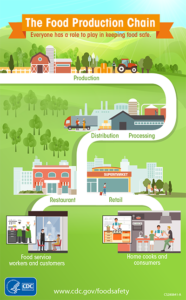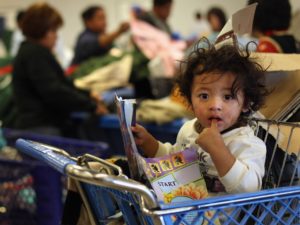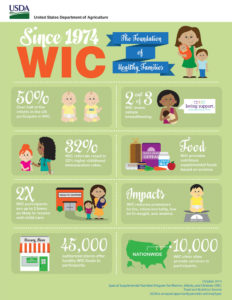Finding the origin of the Recent E-Coli Outbreak in Lettuce 
Food borne illnesses have been on the rise in recent years and, even though NPR explains that it isn’t necessarily a reason to freak out just yet, finding the cause of these outbreaks is something the educated consumer should be interested in. One of the biggest outbreaks this year was the E-coli bacteria found on romaine lettuce. The Food and Drug Administration found this outbreak particularly challenging to solve because there are so many farms in the Yuma, Arizona area, that grow romaine lettuce, and E-coli was found at numerous farms. Also, the neighboring cattle feedlot shares a water irrigation system with many of these farms, which means its easy for contaminated run-off to affect its neighbors. It’s even possible that the infected dirt from the feedlot may have become airborne and landed in the lettuce fields. Another issue is that many processing centers use lettuce from different farms and cut and package it all together. This makes it hard to nail down exactly where the contaminated lettuce comes from.
The entire outbreak brings up two major issues within our food system. One, is our current food production chain. Most non-organic, (and even some organic vegetables as well), are grown on huge commercial-sized farms. The produce is then shipped to processing centers to be washed and packaged, then brought to distributors, who then deliver it to restaurants and stores. The CDC outlines (Center for Disease Control) how there is a higher possibility of food being contaminated when it has to travel far distances. Another, is the issue of industrial meat production. The way that cattle are raised on huge feedlots leads to more infections in the animals. A Cornell Study shows that, if animals were raised eating grass and not grain or corn feed, they would not develop as many infections.
Preventing outbreaks may require a fundamental change in our farming system all together. In the meantime, the lettuce farmers are thinking about purchasing the land from the feedlot company and shutting it down, to prevent this from happening in the future. This would be a start!
To read the full article click below:
Fighting Food Waste through Gleaning from Farms in the UK
The food waste issue facing our world today is a big one. The NY Times wrote a great article on food waste in December, bringing to light some of the hard facts of the issue:
- Globally we throw out about 1.3 Billion tons of food a year, or a third of all the food that we grow.
- The United States as a whole wastes more than $160 Billion a year in food.
- Food waste and loss has a 3.3 Billion tons of carbon equivalent.
- Farmers overproduce by about 20%
This is an important issue to be aware of because the food we waste has a trickle down effect on everything from our environment to our health. A USDA report documenting food waste, and a report showing the connection of food waste and our carbon footprint help paint a picture for consumers of the issue. Mass production of food causes harm to the environment, so by finding ways to reduce waste we can make a difference in our carbon footprint globally. There are people around the world popping up that are finding ways to reduce waste. One great documentary highlighting this issue is Wasted! A Food Waste Documentary. Here is the trailer:
Little changes can make a difference. We see this highlighted in the UK, where farms are allowing “gleaners”, to come and harvest “wasted” fruit. This “wasted” fruit is fruit that has blemishes, or has fallen on the ground and doesn’t look perfect. One of the issues with food waste is that farms produce an excess amount of produce to meet consumers perfectionist standards. Farmers cannot sell fruit and vegetables that have blemishes, or aren’t so-called ‘perfect looking’, even if they taste the same as other produce. The gleaners come in and harvest these non-perfect fruits and vegetables and donate them to food banks in large cities. It works well for everyone involved! The farmers are happy that someone is clearing out their orchards, making it easier to replant etc, and people who wouldn’t be able to buy fresh produce are getting it at the food banks.
Watch the full video below!
Immigrants Across the US Receiving Federal Food Aid Are Dropping Out
Many immigrant families are opting out of federal food aid programs like WIC, (the Woman, Infant and Children Program), due to President Trump’s harsh immigration laws. The White House announced that they will be putting out a policy that will deny immigrants citizenship if they have been receiving federal aid of any kind. The problem is that many immigrant families need the federal aid help in order to feed their children, who are U.S. citizens. By dropping out of the program they are putting themselves and their children at risk of being malnourished. The policy hasn’t been put into effect yet, but Politico reports that it has already scared immigrants enough that many states have seen up to a 20% drop in the enrollment for the programs.
This change could end up costing the government more money, because malnourished people are more susceptible to illness and disease, and in turn need more medical care.
Politico talked directly to people working within the program:
“Maria Isabel Rangel, a graduate student at the University of California, Berkeley, recently interviewed ten farmworker families in California whose households included both legal and undocumented immigrants. She said they described dealing with “constant anxiety,” even when they’ve decided to keep using programs like WIC, Medicaid and SNAP (food stamps.)
“They’re worried that their documentation status will somehow be jeopardized by participating in these health programs,” Rangel said. “They say: ‘I can’t stop using these programs because my children need them, but I know I’m risking my future and the future of my children.’”
WIC has been largely immigration-blind since it was created in 1974. Most of the infants it serves are citizens born in the U.S., regardless of their parents’ immigration status. Despite that, providers say parents’ fear of deportation may also be driving declining enrollment in WIC.”
To read the full story click here:
https://www.politico.com/story/2018/09/03/immigrants-nutrition-food-trump-crackdown-806292?cid=apn
Fish Sold as “Local” Found Not To Be, Investigation into the Sea-to-Table Organization
I was shocked to read this article in The Associated Press! Sea-to-Table, a sustainable fish distributor company, who’s Founder was a guest on my radio show, has been selling fish that was mislabeled!! The company markets itself as a distributor of sustainably caught seafood. However, it was found that some of the fisherman and markets they were sourcing from weren’t telling the complete truth about the fishes origin. One example was tuna that was supposedly coming from Montauk, NY, in the middle of winter, was really coming from North Carolina. Tuna migrate to warmer waters in the winter months, so there is no tuna on Long Island. The investigation found many other examples of similar problems within the supply chain. The Sea-to-Table CEO and founder put out a Q&A statement on their website in an attempt to clear things up, and they have since cut ties with Gosman’s, the Montauk fishing hub responsible for the deception, but this revelation still brings up larger issues of mislabeling, mis-marketing, and transparency within our food supply chain.
An organization that helps connect you directly with local community supported, small-scale fisherman is called Local Catch. If you are seeking out local fish or shellfish they even provide a seafood finder, which allows you to type in locations and types of seafood and shows you sustainable places to get that product. Knowing your local fisherman is another great way to know exactly where your fish is coming from!
To read the full AP article click here.
The AP created this video which explains how fish gets from the sea to our table.




Comments are closed.